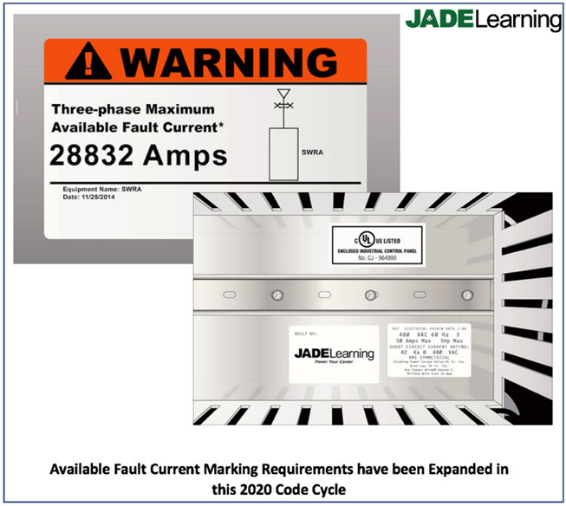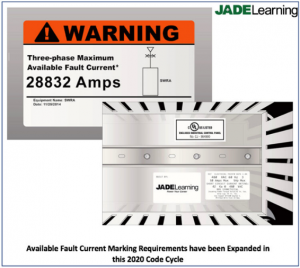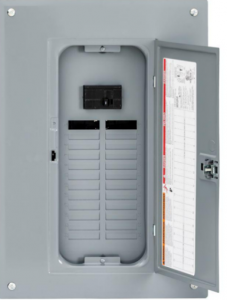Short-Circuit Current-Rating (SCCR) VS. Available Fault Current: Understanding the Maze and What’s New for 2020

By: Jerry Durham | Jun 03, 2020
Section 408.6: A Brand-New Addition to the 2020 NEC
NEC section 408.6 states: Switchboards, Switchgear, and Panelboards shall have a short-circuit current rating (SCCR) not less than the available fault current. In other than one- and two-family dwelling units, the available fault current and the date the calculation was performed shall be field marked on the enclosure at the point of supply. The marking shall comply with 110.21(B)(3).
Making NEC 408.6 Simple
This new Code Section simply means that electrical panels including main-breaker and main-lug type panels and switchboards & switchgear equipment must be rated (in amps) to withstand the high levels of current that will flow should a short-to-ground or other fault occur at the equipment. In ALL locations other than dwelling units, that anticipated fault current must be marked on the equipment enclosure near where the supply conductors enter in, along with the date that the calculation producing that number was performed. The new Code Section also says the markings on the equipment must comply with 110.21(B)(3). Section 110.21(B)(3) tells us that markings must be sufficiently durable to withstand the environment.
This new Code Section requiring electricians to mark all Switchboards, Switchgear, and Panelboards is similar to an existing NEC Section (110.24) that demands the same kind of marking but only for service equipment. Service equipment (The First Means of Disconnect) is the equipment that contains the main switch (example: main breaker) that terminates power for all of the premises wiring. 
Section 110.24 required that the Available Fault Current be marked on service equipment only (such as main-breaker panels and similar main-switch panels). But newly added Section 408.6 extends that requirement to include every type of panelboard/switchboard/switchgear, at every location except dwelling units. In addition to requiring the Available Fault Current marking on all named enclosures, 408.6 requires the DATE the calculation was performed to be on the enclosure as well. (Note: It does NOT say the calculation must be marked on the equipment, only the DATE the calculation was performed. That is a big difference.)
A Closer Look at the Two Terms Used in 408.6
Section 408.6 in the 2020 NEC tells us: The SHORT CIRCUIT CURRENT RATING (SCCR) of equipment can be no less than the AVAILABLE FAULT CURRENT.
What do these two terms mean?
Short-Circuit Current Rating (SCCR)

Short-Circuit Current Rating (SCCR) is an equipment rating. This rating (in amps) is the equipment’s ability to withstand high levels of current that will flow on the grounded metal of the equipment should a short-to-ground or other fault occur. The equipment must be able to withstand this “fault current” without experiencing a meltdown, explosion, or similar catastrophe.
Available Fault Current
Available Fault Current is NOT an equipment rating but is instead the maximum amount of objectionable (unwanted) current that will flow on that equipment, should a fault occur.
Now that we understand these two terms, it is easy to see what is meant in the first sentence of the new Code: Switchboards, Switchgear, and Panelboards shall have a short-circuit current rating (SCCR) not less than the available fault current.
“Available Fault Current” is just one of many terms available to the NEC to describe runaway current at a piece of equipment. There are other terms used by the NEC, so don’t get confused if you see them. These include Maximum Fault Current and Available Short-Circuit Current. All of these just mean “Available Fault Current” as it is used in this new Code section, 408.6.
A Simple Rule
Just remember, for all these different and confusing terms only one of them contains the word rating. When you see “rating” as part of the term, as in Short-Circuit-Current-Rating (SCCR), it is referring to equipment, specifically the equipment’s ability to withstand explosive fault current. The other terms are just the many ways of referring to this explosive fault current that gets released onto equipment when a fault occurs.



I’m not sure I understand the comment by the author pointing to the fact that 408.6 does not require the calculation only the date? Doesn’t 408.6 require that all panelboards switchboards and switchgear no matter where they are in any system, need to be marked with the available fault current and the date that was determined.
Why confuse the issue by pointing out that you don’t have to show the calculation. It makes me wonder if I’m missing the point. A distinct possibility 🙂
Hi Mike,
You did not miss the point. In sum: Section 110.24 from the 2017 NEC required that the Available Fault Current be marked on all (except dwelling) service equipment—but ONLY service equipment and not any other types of electrical equipment. (NOTE: Service equipment includes main-breaker panels and any other main-switch equipment able to terminate the connection between premises wiring and the utility provider wiring). The NEC revised that requirement. In the 2020 NEC, Section 408.6 extends that requirement to include every type of panelboard/switchboard/switchgear and not just equipment meeting the definition of “Service Equipment.” And don’t forget- neither the 2017 nor the 2020 NEC requirement applied/applies to dwelling unit electrical equipment. Finally, concerning the (Note:) in the blog that mentions that the calculation used to determine the equipment’s Available Fault Current does not have to be (somehow) affixed to or stored on the equipment, that is a preemptive answer to a question many professionals are not aware is being asked. Electricians often misunderstand this Code section (and two other similar Codes) to mean the calculation is required somehow on the equipment perhaps in a plastic waterproof jacket or similar. These electricians often get the question wrong concerning this topic when it comes up in their electrical continuing education course. The calculation is not required at/on the equipment.
Thanks!
Jerry Durham – JADE Learning Instructor
You say that SCCR is an “equipment” rating, but the AFC is not, and you make a special point of the term “rating.” May I ask what is considered to be “equipment” in those two definitions?
If a 200 A service breaker panel has a 45 A breaker installed to supply power to an HVAC package unit at a residence, is the HVAC packaged unit the “equipment,” or the 45 A breaker, or the breaker panel, or all of the above?
Since you pointed to the term “rating” in connection to SCCR, it makes sense to me that the manufacturer of the HVAC package unit would be responsible for publishing a SCCR (short-circuit current rating) for their HVAC “equipment,” since a “rating” has to be validated by some testing company.
If that is correct, what code, rule, law, or whatever places that requirement on the manufacturer?
Further, since SCCR, AFC, and other concerns of the NEC are derived in an attempt to make electricity safe for humans to use, why the exception “at other than dwelling units” that I see in the NEC whenever it comes to things like “Available Fault Current” [110.24(A)], and “Arc-Flash Hazard Warning” [110.6(A)&(B)], important issues that require a bit of sophistication to deal with?
Underlying my questions posted above:
Why does the NEC exempt RESIDENTIAL service panels (equipment) from sections [110.24] and [408.6]?
Should residential electricians not be concerned about unsafe conditions created by high available fault currents during short circuit conditions? Are residential service panels intrinsically safe? If those electricians aren’t required to perform AFC calculations, won’t they be blind to the possibilities, and not be able to take appropriate preemptive actions when selecting OCPDs?
This needs to be clarified: The CALCULATION need not be posted on the equipment, but the RESULT of the calculation must be.
I have 400A 408/277 Panel; How do I find out Faulty current?
Does equipment such as an industrial 3D printer operating at 115V 60Hz require an SCCR? It does not have anything that can be considered an ICP and is connected to power via an IEC 60320 inlet, but is being certified to UL 2011 which references UL 508A and NFPA 79. Is there an exemption for SCCR for this type of equipment or a simplified process for deriving it?